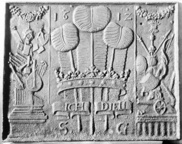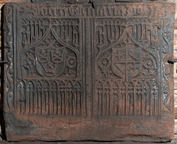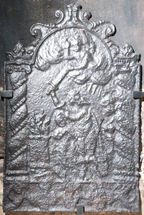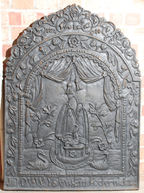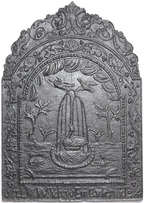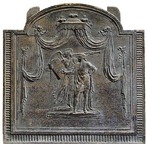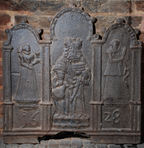-
1291
Description: Rectangular shape; astragal with cavetto-moulded edging; decoration in three vertical sections each divided by a fillet; central section: three ostrich feathers within a coronet and a motto scroll - ICH DIEN (I serve); at the top, the date split either side of the uppermost feather; at the bottom, initials - SG - split either side of the quills; left panel: on a pedestal, an arrangement of musical and scientific instruments and books below a floral swag with a central rose; right panel: on a palisade, a triumph of martial arms - cannon, drum, shield, spear, flag etc. - beneath a floral swag and handful of arrows.
Notes: The three ostrich feathers within a coronet and the motto, Ich Dien, are the badge of the Prince of Wales. Probably a fireback in honour of Henry Frederick, Prince of Wales, oldest son and heir of King James VI of Scotland, I of England, with the date added to commemorate his death in 1612. The initials are likely to be those of the pattern maker.
Inscription: 16 12 / ICH DIEN / S G
- Decoration tags:
- rectangular (shape)
- astragal with cavetto (edging)
- whole carved pattern
- individual numbers
- heraldic
- pictorial
- historical
- architectural
- royal
- text
- objects
Manufactured: in 1612 in the Eifel area of Germany.
Current location: not known.
Museum number: RBA 37533 (part of the Ahrgau-Museum, Ahrweiler museum group)
- Attached to series:
- Prince of Wales firebacks
- Miscellaneous royal firebacks
-
277
Description: Arched rectangular with cavetto-moulding along top, supported by Ionic pilasters; English Stuart royal shield, garter, helm, crown, motto and supporters; date below and either side of garter.
Notes: One of several firebacks, all of the same date, but varying in size, framing style and moulding; all have stylistic features in common and will have been the work of the same pattern maker, who was also responsible for carving royal coats of arms in three West Country churches. Mendip Auctions, Binegar, 11 Dec 2021, lot 537. Copies of this fireback were advertised in Bratt Colbran Ltd.'s (London) catalogue in the early-20th century.
Copies of this fireback are known.
Inscription: I R [Jacobus Rex] / HONI SOIT QVI MAL Y PENSE / 16 18 / DIEV ET MON DROIT
Arms: English Stuart royal (James I)
- Decoration tags:
- rectangular with round arch (shape)
- complex individual (edging)
- whole carved pattern
- architectural
- armorial
- royal
- text
Manufactured: in 1618 possibly in the Forest of Dean area of England.
Current location: not known.
-
889
Description: Arched shape; fillet edging; swan within a voided strapwork cartouche; date in Arabic numerals, at bottom, on a broad horizontal fillet.
Notes: Stylistically, of the early 17th century, suggesting the date is 1617, although the third numeral is indistinct. Bonham's sale, Chester, 18 October 2012, lot 384 (£375).
Inscription: 16 1[?]7
- Decoration tags:
- rounded arched (shape)
- fillet (edging)
- whole carved pattern
- heraldic
- architectural
- text
- animals
Manufactured: in 1617 in England.
Current location: not known.
- Attached to series:
- Miscellaneous pattern firebacks
-
810
Description: Rectangular; carved strip with undulating vine between fillets, repeated on each side; carved inscription panel along top edge; centre, two traceried panels, each with a central shield beneath a gothic arch.
Notes: One of several similar firebacks produced in the same period.
Copies of this fireback are known.
Inscription: JHESUS MARIA JHONES
- Decoration tags:
- rectangular (shape)
- fillet (edging)
- simple stamps
- carved stamps
- architectural
- armorial
- text
Manufactured: in the early-16th century possibly in the Eifel area of Germany.
Current location: in private hands, Cox Green, Berkshire, England.
- Attached to series:
- Foreign armorial firebacks
-
1001
Description: Arched rectangular panel with a Salomonic column on each side enclosing a scene of Abraham about to sacrifice Isaac but being restrained by an angel; below, bottom panel of indeterminate decoration (due to corrosion); above each column a burning torch, with symmetrical floriate scrolls over the arch.
Notes: Given the biblical subject, this is probably of German manufacture although the Salomonic columns are more often encountered on English pastiches of the 'Dutch' style.
- Decoration tags:
- 'Dutch' (shape)
- fillet (edging)
- whole carved pattern
- pictorial
- biblical
- architectural
- humans
- objects
Manufactured: in the late-17th to early-18th century possibly in the Siegerland area of Germany.
Current location: Ashmolean Museum Broadway, 65 High Street, Broadway, Worcestershire, England.
(part of the Ashmolean Museum museum group)
- Attached to series:
- Old Testament & Apocrypha firebacks
- 'Dutch' Miscellaneous Firebacks
-
1121
Description: Rectangular shape; cavetto-moulded edging; central abstract arrangement in low relief of a horizontally positioned oval surrounded by four separated spandrels forming a rectangular shape over all; at each side, on a raised rectangular field, a stylised bud or cone of helical form, within a calyx above a semi-circular base, one mirroring the other. A deep plankline is evident half way up the left plant.
Notes: An excrescence on the right side may have been caused by iron being poured from a ladle disturbing the casting sand. There are no parallels for this fireback design. The central abstract arrangement may be associated with a formal plan of a garden parterre, the stylised plants continuing that theme.
- Decoration tags:
- rectangular (shape)
- cavetto (edging)
- whole carved pattern
- planklines
- architectural
- plants
- objects
Manufactured: in the early- to mid-17th century in the Weald area of England.
Current location: in private hands, Buxted, East Sussex, England.
- Attached to series:
- Miscellaneous pattern firebacks
- Garden design types
-
226
Description: Arched rectangular shaped central panel with bead-and-pellet edging on a wide fillet; central pedestal with a wyvern fountain ringed with water, and a swan and a duck swimming, plants rising from the waves; above, swags of drapery with two central tassels; arched rectangular shaped border with fillet edging, symmetrical floral fronds descending from a rose, top centre, with a looped 'W' in each shoulder; inscription at base, between date; on top, symmetrical scrolled plant tendrils. A single vertical plankline right of centre.
Notes: One of a group of firebacks all of the same date, some of which have the same Welsh inscription which translates as 'God is our strength'. All incorporate the looped 'W' motif which may be intended to identify the pattern maker. The design is taken from 'Livres de Fontaines' by Daniel Marot (1661-1752) (La Haye & Amsterdam 1701). The swan and the duck swimming may have been copied from etchings or paintings by Francis Barlow (c.1624-1709), whose images of birds have been used incidentally on other firebacks. Formerly at Allt-y-ferin, Nantgaredig, Carmarthenshire.
Copies of this fireback are known.
Inscription: 17 DVW Ydyw Ein Cadernid 24
- Decoration tags:
- 'Dutch' (shape)
- fillet (edging)
- whole carved pattern
- planklines
- pictorial
- architectural
- text
- animals
- plants
- objects
Manufactured: in 1724 in England.
Current location: National History Museum, St Fagans, Glamorgan, Wales.
Museum number: 62.156 (part of the Welsh National History Museum museum group)
- Attached to series:
- 1724 series
- Welsh inscription series
- British 'Dutch' style firebacks
-
240
Description: Arched rectangular shaped central panel with bead-and-pellet edging on a wide fillet; ground with birds, and trees behind; in the centre a circular fountain rim with a swan on a plinth surrounded by water, with jets of water rising from the swan’s mouth and descending on either side; above, a heron and a goose fly to the left; under the arch, swags of drapery; arched rectangular shaped border with fillet edging, symmetrical floral fronds descending from a scallop shell, top centre, with a looed 'W' in each shoulder; inscription at base between date; on top, symmetrical scrolled plant tendrils. A single central vertical plankline.
Notes: One of a group of firebacks, all of the same date, some of which have the same Welsh inscription which translates as 'God is our strength'. All incorporate the looped 'W' motif which may be intended to identify the pattern maker. The design is adapted from an illustration of fountain no. XXXIX, 'Les Cannes et le Petit Barbet' in Labyrinthe de Versailles by Sébastien le Clerc (1677); the flying heron and duck are copied from illustrations by Francis Barlow (c1626-1704) or from engravings of his work by Wenceslaus Hollar (1607-77).
Copies of this fireback are known.
Inscription: 17 DVW Ydyw Ein Cadernid 24
- Decoration tags:
- 'Dutch' (shape)
- fillet (edging)
- whole carved pattern
- planklines
- pictorial
- architectural
- text
- animals
- objects
Manufactured: in 1724 in England.
Current location: Newton House, Dinefwr, Llandeilo, Carmarthenshire, Wales.
Museum number: F83.116 (part of the Welsh National History Museum museum group)
Citation: Lloyd, N., 1925, 'Domestic Ironwork I', Architectural Review, 58, pp. 58-67.
- Attached to series:
- 1724 series
- Welsh inscription series
- British 'Dutch' style firebacks
-
933
Description: Carved wooden fireback pattern. Arched rectangular shape with fillet and cavetto-moulded edging; a canopy with swagged drapery descending from ribbon bunches, beneath which stand two figures: behind, a female angelic figure, right breast exposed, blowing a trumpet held in her left hand and holding an arched rectangular shield in her right hand; in front, a classically dressed male figure wearing a face mask; slatted extensions to the side and bottom; two battens to the rear of the pattern, visible at the top.
Notes: The significance of the scene has not been identified. Christie's auction 3 Jul 2002 lot 160 (£588).
- Decoration tags:
- rectangular with round arch (shape)
- fillet (edging)
- whole carved pattern
- planklines
- pictorial
- architectural
- humans
Manufactured: in the mid- to late-18th century in France.
Current location: not known.
- Attached to series:
- Patterns
-
888
Description: Triple arched rectangular shape, centre arch higher; each arch supported by pilasters; within centre arch, cloaked, bearded male figure wearing a crown and carrying a ewer and what appear to be a pile of plates; in left arch, above first half of date, a clothed female figure carrying a goblet and possibly a candle on a staff; in the right arch, above the second half of the date, a clothed female figure holding a distaff and a length of wool; there is a narrow panel at the bottom; on the outside of the arches are scroll-shaped protusions.
Notes: The shape of this fireback is relatively uncommon, and the significance of the figures may relate to a particular narrative.
Inscription: 16 28
- Decoration tags:
- rectangular with three arches (shape)
- complex individual (edging)
- carved stamps
- whole carved pattern
- individual numbers
- architectural
- text
- humans
Manufactured: in 1628 possibly in the Eifel area of Germany.
Current location: in private hands, Cowden, Kent, England.
- Attached to series:
- Figurine firebacks
